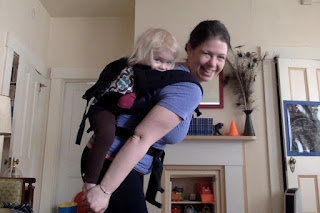A structured carrier is a carrier with at least one of the following:
-a structured waist
-a structured body panel
-buckled on shoulder straps
-buckled on waist strap
Carrier modifications (e.g., infant inserts) are generally neither designed nor intended for back carries, because you cannot monitor to see if the modification is in the right position or if it is staying in the right position. Also, it is super tricky to load a baby on back with modifications in place and a pretty significant fall risk.
Baby is ready for a back carry in a structured carrier, when
-baby is a full term 4 month old, because incident data suggest that baby’s younger than 4 full term months have a higher risk of suffocation in baby equipment
AND
-baby is not having a respiratory complication (medical consultation/approval needed), because incident data suggest that babies (especially younger babies) with respiratory complications, even a common cold, have a higher risk of suffocation in baby equipment
AND
-baby is tall enough to fit in the carrier so that ears are above top of panel, because incident data suggest that baby’s airway (nose, mouth, chest) needs to be visible
AND
-baby has legs long enough to be able to sit in the carrier with bum in seat of carrier and knees higher than bum and not inside the carrier, because incident data suggest that unseated babies can slump onto their airway or fall from the carrier
AND
-baby fits firmly between the carrier and caregiver without torso movement for leaning or slumping, because incident data suggest that loosely worn babies can slump onto their airway or fall from the carrier
AND
-baby has good head, neck, and torso control (we know all 3 have occurred once baby begins to learn to sit unassisted), because incident data suggest that babies at lesser gross motor skill stages have a higher risk of suffocation
Incident data drawn from the Soft Infant and Toddler Standard:
Proposed standard for Slings, which is currently free to view and has incident data:
More info from the CPSC:
http://www.cpsc.gov/en/Business--Manufacturing/Business-Education/Business-Guidance/Soft-Infant-and-Toddler-Carriers/
For information on where to place the waistband on your waist/hips, see this video:
Black on Yellow is the easiest combo to read and remember:
Black on aqua is pretty:
For information on where to place the waistband on your waist/hips, see this video:
Black on aqua is pretty:



No comments:
Post a Comment